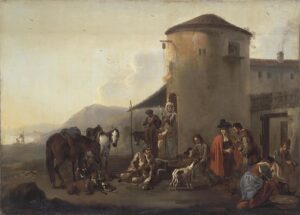Miel’s halt on the hunt and repas de chasse depicts hunters stopped by a rustic inn.
In the Prado’s La Merienda, hunters have spread a cloth beside their horses and are settling in to relax. This is a perfunctory meal of sliced ham, cheese, bread, and wine. Unlike Watteau’s fashionable hunters and their ladies in scenes, Miel’s focus in La Merienda is the lower classes, servants, and servers. The principal hunter sits on horseback facing away from the viewer while his servants eat a perfunctory meal of sliced ham, cheese, bread, and wine. Nonetheless, the hunter’s lady (left midground) is now approaching on horseback and carrying an umbrella to shade her from the midday sun.
In the Hermitage’s Hunters at Rest, the focus is the aristocratic hunter who stands looking down at his helper, who sits on the ground with the dogs. He waits for his lady, who is approaching. 
Miel was a Belgian who settled in Rome and Turin. He was closely associated with the Bamboccianti, a group of Dutch and Flemish that specialized in rustic and urban subjects of everyday life. Bamboccianti is Italian for puppets or ugly dolls.
Featured Image: Jan Miel. La Merienda [Halt on the Hunt or Picnic] (1650s), oil on canvas. Museo del Prado; http://cvc.cervantes.es/artes/museoprado/citas_claroscuro/holandeses_flamencos_xvii/galeria_holandeses_flamencos_xvii.htm
